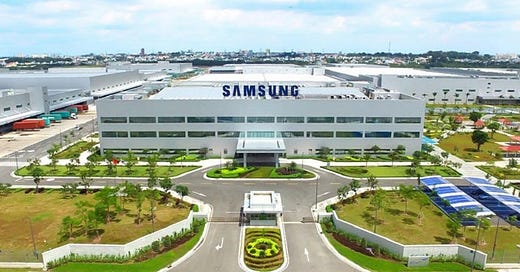Vietnam Rises as Seoul’s New Economic Partner
Seoul abandons China for a new collaboration
By: Shim Jae Hoon
South Korean businesses are turning to Vietnam as a newly diversifying market, deserting China with its reputation as an increasingly coercive business partner. On the exodus trail are no longer labor-intensive garment makers and footwear producers, they now include electronic giants like Samsung and LG home appliances. In the past three decades since resumption of diplomatic relations, South Korea has turned into the biggest foreign investor in Vietnam, transforming the country’s image from a farming to a newly industrializing nation.
It is one of Asia’s most remarkable stories of evolution from wartime enemies to peacetime economic partnership. South Korea had fought alongside the US in the Vietnam War, earning opprobrium for being a US mercenary. While that image has long tormented Korean veterans of the war, a Seoul court has recently ruled that the Korean government should compensate for the killing of Vietnamese villagers by Korean marines during a battle in central Vietnam. While the case will be heard at a higher court, the Vietnamese government itself has waived all wartime claims against belligerents including South Korea.
In today’s peacetime economic relations, Vietnamese and South Koreans are all over in each other’s countries. Statistics tell the whole story: 150,000 South Koreans live and work in Vietnam, while 200,000 Vietnamese do so in Korea, quite a few of them as spouses married to Koreans. In Ho Chi Minh City and Hanoi, Koreans have built hotels and modern apartment blocks.
Their bilateral trade last year rose to over US$86 billion, a remarkable jump from a puny US$500 million three decades ago, when diplomatic relations resumed. While last year’s figure was tiny when compared to Seoul’s global total, it nevertheless amounted to 65 percent of Seoul’s entire trade with the multination Asean bloc. With Vietnam entering a couple of Asian free-trade blocs, including an FTA with Seoul, future bilateral volume is expected to rise exponentially, with officials of both countries predicting this year’s bilateral totaling $100 billion.
At first sight, their trade is heavily unbalanced against Hanoi, with imports amounting to US$59 billion last year against exports to Korea of US$26.4 billion. But figures indicate that most imports from Korea go to Korean-invested companies in Vietnam. They consist of intermediate parts and industrial raw material for processing by Korean-invested plants and factories for processing by Vietnamese workers for export to third country destinations. It is a repeat pattern of what South Korea itself had gone through with Japan back in the 1960s and 1970s in the early period of Seoul’s own industrialization. Japan-invested companies in South Korea imported parts and material for exports to international markets; Korea today is repeating that process in Vietnam.
If the pace of trade today appears accelerating, officials in Hanoi and Seoul appear even more bullish for the future. Vietnam President Nguyen Xuan Phuc, visiting Seoul last December, predicted that the two-way trade will reach a US$150 billion mark by 2030. He also said Seoul’s investments in Vietnam will hit US$100 billion by that time.
This trend is expected to continue for the next few years as Vietnam develops into a major manufacturing nation in Southeast Asia. Examine the items that go to Vietnam and it becomes clear why the growth will cover a lengthy period. They mostly comprise parts and components like semiconductors, Nano and Nand flash memory chips, liquid panels for TV sets, cellphone parts, informatics like computers and cellphones. All these are assembled at Korean-invested factories for export to the global markets. Given the present trends, Vietnam is expected to rise as a major manufacturing hub within a decade. In recent years, investments are moving into service categories involving distribution, real estates and other service categories.
Recent Vietnamese figures indicate Seoul’s investments in Vietnam totaling a cumulative US$80 billion between 1988 and 2022 in over 9,000 projects. If many involved small manufacturing and labor-intensive cases, new projects involve larger investment units such as for iron and steel, electronics and home appliances. According to recent Korean figures, investments in bigger projects in the first nine months of 2022 amounted to US$3.8 billion in 290 projects.
Among industrial giants present in Vietnam are Pohang Iron and Steel, Hyundai Motors and Shipbuilding. Korea’s giant construction magnates are already in Ho Chi Minh City, building office blocks and residential apartments. Many small investors are crowded around Ho Chi Minh City, while big industrial investors are located near Hanoi. LG electronics, Korea’s giant home appliance maker, is investing US$7 billion for a new smart phone project. Samsung is said to be newly investing US$2 billion this year for a new chip production site, bringing its Vietnam investments to a total of US$17.6 billion. Late last year, the conglomerate inaugurated its biggest research and development center in Southeast Asia, a new research facility opened in Hanoi at an estimated cost of US$220 million. This is just the latest investment from the South Korean electronics behemoth, which has been manufacturing in Vietnam since 2008. Since then, it’s estimated that Samsung has invested upwards of US$18 billion, and is expected to invest even more this year.
While some Korean investors complain about bureaucratic red tape and other problems like petty corruption, Vietnam itself is poised to become a major industrial power in Southeast Asia with an open economy achieved through Doi Moi reform and an open-arm welcome for foreign investment. Vietnam has also joined a variety of free trade blocs in recent years. Although the country is under firm communist party control, its economy is surging, despite the impact of the Covid-19 pandemic and global supply chain slowdowns. Government targets for 2023 aim for a 6.5 percent GDP growth and per capita income of US$4,400 for a population reaching 100 million. That’s no small feat for a country emerging from years of war and devastation.



